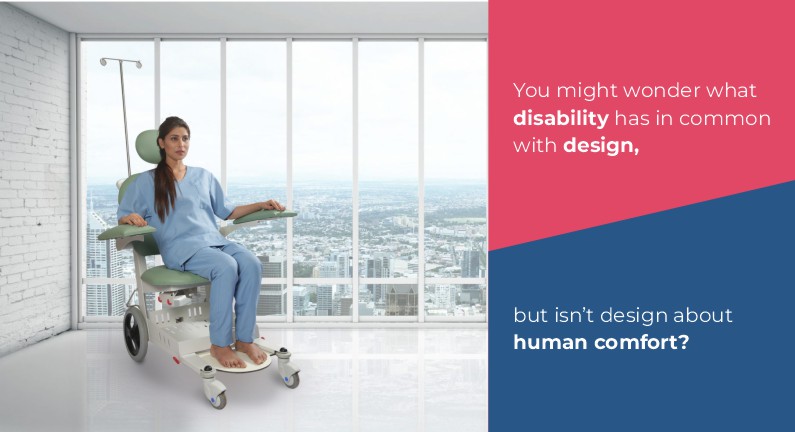Disability is any condition of the body or mind (impairment) that makes it more difficult for the person with the condition to do certain activities (activity limitation) and interact with the world around them (participation restrictions).
For many newly disabled patients, the loss of mobility, independence, and dignity can often be more paralyzing than the loss of sensation in their appendages. Just making it through a routine doctor’s office visit can be a most daunting and challenging experience.
What do we understand by disability? Disability is not just a limitation for a few people it is a part of human life that everyone would experience at some point situationally, temporarily, or permanently. You might wonder what disability has in common with design, but isn’t design about human comfort?
Everything around us has been designed in some way and all design ultimately produces an emotion. We experience an emotional reaction to our environment moment-by-moment: a like or a dislike, elation, joy, frustration. We ‘feel’ it. It’s personal. This plays an impactful role in healthcare facilities where every space, product, and solution are aiding in the recovery of the patient.
When choosing healthcare products for patient care and designing healthcare spaces, accessible and inclusive designs play a significant role. Health services and activities are often located far away from where most people live or in an area not serviced by accessible transport options. Stairs at the entrance to buildings or services and activities located on floors that do not have elevator access are inaccessible. Inaccessible toilets, passages, doorways, and rooms that do not accommodate wheelchair users, or are difficult to navigate for people with mobility impairments, are common. Fixed-height furniture, including examination beds and chairs, can be difficult for people with disability to use. Health facilities and other venues for activities are often poorly lit, do not have clear signage, or are laid out in a confusing way that makes it hard for people to find their way around.
Disability is often not perceived as a health issue Therefore, action is not taken toward disability inclusion in the health sector, which is also often overlooked in strategies. Attaining the highest possible standard of health and well-being for all will only be possible if organizations and individuals understand the need for a paradigm shift, recognizing that the product or service designed is successful only when it is accessible by all. Eyeglasses have been transformed from a medical necessity to a fashion accessory. When design meets disability, the diversity of complementary, even contradictory, approaches can enrich each field.

Midmark Response
In the legacy of seven decades, Midmark India has witnessed the evolution of a functional or utilitarian design that very much subscribes to the “form follows function” style prevalent since the early 20th century to interactive and user-friendly design where the user not only interacts with the product but forms an emotional relationship with it. Lately, our approach has also changed in this regard wherein we are focused on the patient and healthcare provider’s needs. How can the product be accessible to all? What constitutes a good design? How can the products aid in patient recovery? How can we make healthcare providers’ work efficient?
As we address these questions by designing user-centric products, this year on World Disability Day we pledged to have an impact by providing accessible, inclusive, and responsive design for an overall greater healthcare experience.
To know more about wheelchairs and medical table, please visit https://www.midmark.in/ or call 1800 22 8020
